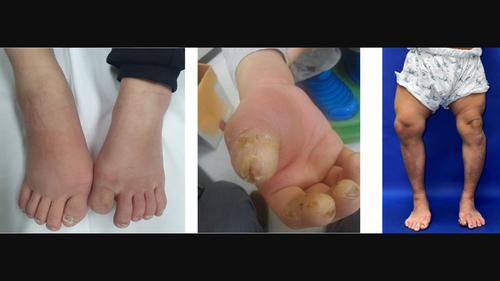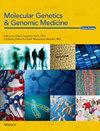Clinical and genetic characteristics of three patients with congenital insensitivity to pain with anhidrosis: Case reports and a review of the literature
IF 1.5
4区 医学
Q4 GENETICS & HEREDITY
引用次数: 0
Abstract
BackgroundCongenital insensitivity to pain with anhidrosis (CIPA) is an extremely rare autosomal recessive disorder caused by loss‐of‐function mutations of the

三例先天性痛觉不敏感合并无汗症患者的临床和遗传特征:病例报告和文献综述
背景先天性痛觉不敏感伴潮湿症(CIPA)是一种极其罕见的常染色体隐性遗传疾病,由NTRK1基因功能缺失突变引起,影响自主神经和感觉神经系统。临床表现多种多样,包括反复发热、对疼痛不敏感、多汗症、自残行为和智力障碍。两名患者有自残倾向、智力障碍和发育迟缓。发现了四种 NTRK1(NM_002529.3)突变,分别为 c.851-33T>A(p.?)、c.2020G>T(p.Asp674Tyr)、c.2303C>T(p.Pro768Leu)和 c.574-156_850+1113del(5-7 del 外显子)。两名患者表现出早发和严重的表型,分别是NTRK1的c.851-33T>A(p.?)突变的同源杂合子和c.851-33T>A(p.?)和c.2020G>T(p.Asp674Tyr)突变的复合杂合子。第三位患者为c.2303C>T(p.Pro768Leu)和c.574-156_850+1113del(5-7 del外显子)复合杂合突变,起病较晚,临床表现较轻。这项研究丰富了我们对 CIPA 临床和遗传方面的认识,突出了不同的表型和疾病严重程度。
本文章由计算机程序翻译,如有差异,请以英文原文为准。
求助全文
约1分钟内获得全文
求助全文
来源期刊

Molecular Genetics & Genomic Medicine
Biochemistry, Genetics and Molecular Biology-Genetics
CiteScore
4.20
自引率
0.00%
发文量
241
审稿时长
14 weeks
期刊介绍:
Molecular Genetics & Genomic Medicine is a peer-reviewed journal for rapid dissemination of quality research related to the dynamically developing areas of human, molecular and medical genetics. The journal publishes original research articles covering findings in phenotypic, molecular, biological, and genomic aspects of genomic variation, inherited disorders and birth defects. The broad publishing spectrum of Molecular Genetics & Genomic Medicine includes rare and common disorders from diagnosis to treatment. Examples of appropriate articles include reports of novel disease genes, functional studies of genetic variants, in-depth genotype-phenotype studies, genomic analysis of inherited disorders, molecular diagnostic methods, medical bioinformatics, ethical, legal, and social implications (ELSI), and approaches to clinical diagnosis. Molecular Genetics & Genomic Medicine provides a scientific home for next generation sequencing studies of rare and common disorders, which will make research in this fascinating area easily and rapidly accessible to the scientific community. This will serve as the basis for translating next generation sequencing studies into individualized diagnostics and therapeutics, for day-to-day medical care.
Molecular Genetics & Genomic Medicine publishes original research articles, reviews, and research methods papers, along with invited editorials and commentaries. Original research papers must report well-conducted research with conclusions supported by the data presented.
 求助内容:
求助内容: 应助结果提醒方式:
应助结果提醒方式:


